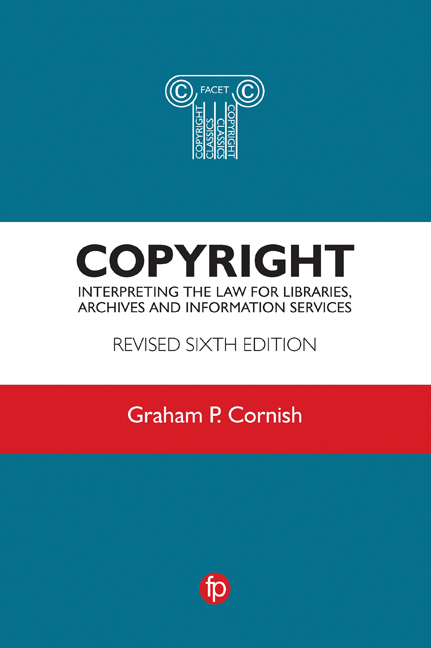Book contents
- Frontmatter
- Contents
- Author's note
- Acknowledgements
- List of abbreviations
- Introduction
- Section 1 Definition and law
- Section 2 What is covered by copyright?
- Section 3 Rights and limitations
- Section 4 Literary, dramatic and musical works
- Section 5 Artistic works
- Section 6 Sound recordings and performers’ rights
- Section 7 Films and videos
- Section 8 Broadcasts
- Section 9 Databases
- Section 10 Licensing schemes and licences
- Section 11 Computer programs, the electronic world and websites
- Section 12 Other matters
- Useful Addresses and Contacts
- Useful Sources of Information
- Appendix: suggested declaration forms
- Index
Section 1 - Definition and law
Published online by Cambridge University Press: 19 November 2019
- Frontmatter
- Contents
- Author's note
- Acknowledgements
- List of abbreviations
- Introduction
- Section 1 Definition and law
- Section 2 What is covered by copyright?
- Section 3 Rights and limitations
- Section 4 Literary, dramatic and musical works
- Section 5 Artistic works
- Section 6 Sound recordings and performers’ rights
- Section 7 Films and videos
- Section 8 Broadcasts
- Section 9 Databases
- Section 10 Licensing schemes and licences
- Section 11 Computer programs, the electronic world and websites
- Section 12 Other matters
- Useful Addresses and Contacts
- Useful Sources of Information
- Appendix: suggested declaration forms
- Index
Summary
What is copyright?
Copyright is part of a batch of rights, usually called intellectual property rights (IPRs), given to the creators of various types of works. Which right is found in a work depends on its nature but the major strands to IPR are patents, trade and service marks, design right, registered design and copyright. These can overlap to some degree and more than one right may be found in a work. This book concentrates on copyright.
Because it is a property right, copyright is governed by the usual rules of property. The owner can sell it, lend or rent it, leave it in a will or just give it away; similarly others can buy or hire it through licences or other agreements. The idea behind copyright is rooted in certain fundamental ideas about creativity and possession. Basically, it springs from the idea that anything we create is an extension of ‘self’ and should be protected from general use by anyone else. Coupled with this is the idea that the person creating something has exclusive rights over the thing created, partly for economic reasons but also because of this extension of ‘self’ idea. Copyright is therefore important to ensure the continued growth of writing, performing and creating generally. If there were no copyright protection there would be little stimulus for people to create anything, as other people would be able to take the work and use it in any way they wanted. This mirrors the usual rules of possessing property. Copyright law aims to protect this growth but, at the same time, tries to ensure that some access to copyright works is allowed as well. Without this access creators would be starved of ideas and information to create more copyright material.
Is copyright a monopoly?
Not entirely. If two people create the same thing independently of each other and without actually copying what the other person wrote or made, then both can claim copyright in what they create, even if they are identical.
Example: Two people stand in exactly the same place and take a photograph. The photos are virtually identical but each photographer owns the copyright in their photo because they did not copy someone else's work.
- Type
- Chapter
- Information
- CopyrightInterpreting the law for libraries, archives and information services, pp. 1 - 6Publisher: FacetPrint publication year: 2019



